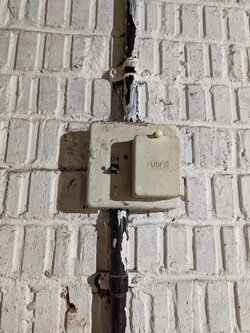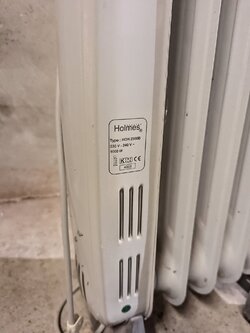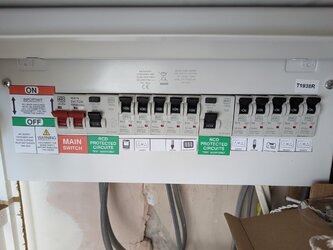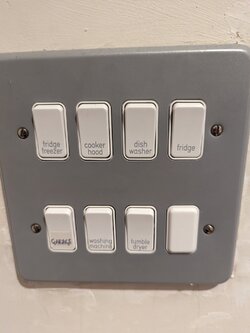Hi,
Just looking to get some advice before I get too carried away with plans for using my garage as a home office/ManCave.
The garage has an old fusebox (photo attached) with 15amp and 5amp fuses which is fed by a 2.5mm cable coming from the house.
The feed to the garage comes from the main consumer unit in the house.
I'm trying to work out if my expected maximum power consumption could be safely handled by both fuses.
Sockets:
Oil filled radiator (photo attached) 1000w @ 240v = 4.17A
Router = <0.5A
TV = <0.5A
Beer Fridge = 0.75A
Coffee Machine = 5.5A
Laptop = <0.5A
Monitor = <0.5A
Projector = 1.9A
LED strip lights =<0.5A
Total Amps = 14.8
Lights:
10x LED downlights 5W X 10 X 240V = 0.21A
2x LED outside lights (4 bulbs) 5.5W X 240V = 0.09A
Total Amps = 0.3
For the sockets, assuming that all of the lower usage appliances all run at 0.5A and are all running at the same time (which wouldn't be the case) I should be within the 15A limit.
Lights are no concern as would be well under the limit.
Am I on the right lines here?
Just looking to get some advice before I get too carried away with plans for using my garage as a home office/ManCave.
The garage has an old fusebox (photo attached) with 15amp and 5amp fuses which is fed by a 2.5mm cable coming from the house.
The feed to the garage comes from the main consumer unit in the house.
I'm trying to work out if my expected maximum power consumption could be safely handled by both fuses.
Sockets:
Oil filled radiator (photo attached) 1000w @ 240v = 4.17A
Router = <0.5A
TV = <0.5A
Beer Fridge = 0.75A
Coffee Machine = 5.5A
Laptop = <0.5A
Monitor = <0.5A
Projector = 1.9A
LED strip lights =<0.5A
Total Amps = 14.8
Lights:
10x LED downlights 5W X 10 X 240V = 0.21A
2x LED outside lights (4 bulbs) 5.5W X 240V = 0.09A
Total Amps = 0.3
For the sockets, assuming that all of the lower usage appliances all run at 0.5A and are all running at the same time (which wouldn't be the case) I should be within the 15A limit.
Lights are no concern as would be well under the limit.
Am I on the right lines here?













